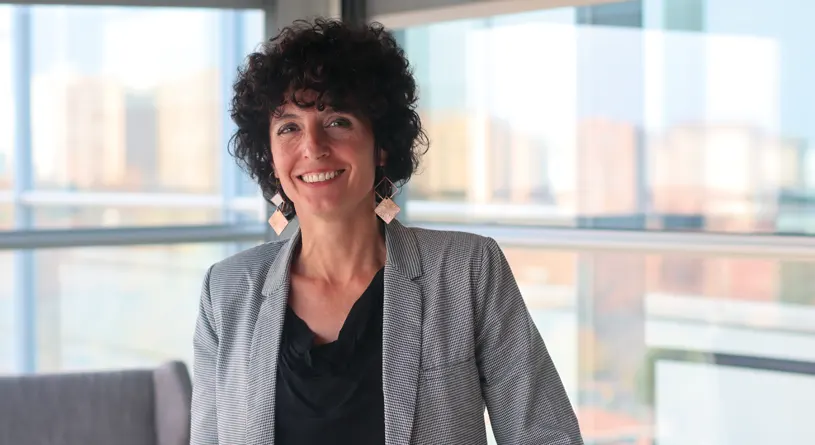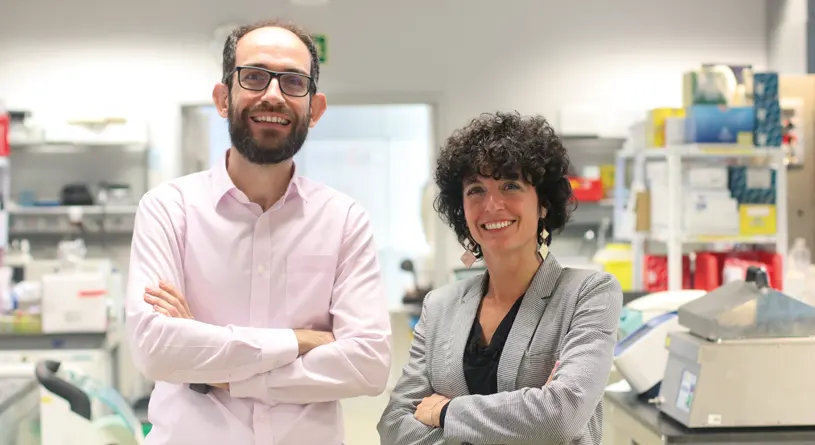Sonia Alonso Martín: “Post-docs are like a golden unicorn”
IIS Biodonostia

Dr Sonia Alonso Martín has worked in the field of skeletal muscle stem cells for the last 16 years. She currently leads a group in the Neuroscience Area of IIS Biodonostia, applying her experience in muscular stem cells to the field of muscular dystrophies and ALS, taking a totally innovative approach in order to better understand diverse neurodegenerative diseases including sarcopenia associated with disuse or age. She is also a research professor in the “Molecular Biology and Biomedicine” doctoral programme at UPV/EHU, the University of the Basque Country. As Group Leader, she received the “Gipuzkoa Fellow for Talent Attraction and Retention” (2019) for her projects promoting a greater understanding of ALS with a muscle-focused approach. She is a member of CIBERNED, the Centre for Networked Biomedical Research in Neurodegenerative Diseases of the thematic research network on extrasynaptic regulation of neural function in neurodegenerative diseases through extracellular vesicles, among other groups.
Your team proposes a new approach to studying amyotrophic lateral sclerosis ALS. What is it?
ALS is a disease that is sporadic in 90% of cases. It produces a degeneration of motor neurons, which are the ones that enable voluntary movements of your whole body, and in the end cause muscular atrophy and respiratory paralysis.
Until now, the approaches in research have always adopted the same point of view, if not for motor neurons, then at least from the nervous system perspective. What we propose is the opposite hypothesis, which is to say, the muscle doesn’t deteriorate because of motor neuron degeneration, meaning it does not receive the necessary input, but rather that maybe the muscle might be part of the onset of the process. So, instead of that top to bottom approach, we think there could be a problem in the muscle and that, in some way, negative signalling impacts in a retrograde way, inverting or promoting the neurodegeneration. We have found positive data when we’ve tried to improve the fitness or state of the muscle to achieve a long-term impact on maintaining or, at a minimum, improving quality of life a little.
How well accepted is this approach?
The truth is that it’s difficult to change a paradigm. There are patients who have died of a different cause, not the disease itself, and we have found that the muscle had already deteriorated, whereas their neurons were perfectly fine.
An animal model has been designed in which, if a mutation is provoked in the disease-specific SOD1 gene that is only expressed in skeletal muscle, it can generate an ALS-like disorder, with symptoms similar to ALS.
However, other approaches based on the overexpression of this mutation in the motor neuron or the glia in different tissues, have produced neurodegeneration but not an ALS. There is evidence that is encouraging an increasing number of people to undertake research along these lines. Now, it is probably neither A nor B, it’s most likely a combination of both things, but it is curious that one of the causes of death should be associated with muscular atrophy.
For me, coming from the world of skeletal muscle, where I have spent over 15 years researching skeletal muscle, what surprises me is the fact that the muscle is damaged.
How had nobody researched this before? When does the damage begin in the muscle? Some of our current projects are precisely on presymptomatic models, which is to say they are on animal models before the disease develops.
We have set ourselves skeletal muscle as a therapeutic target, not the only one, but one to bear in mind
As a new field is being opened, will there be a new therapeutic target to tackle ALS?
We have set ourselves skeletal muscle as a therapeutic target, not the only one, but one to bear in mind. You have to consider that the only approved treatment in Spain is riluzole, which causes hardly any change in the disease over the course of a month. Ultimately, this means nothing. Nowadays the disease is classified as rare, but it is not so rare, it’s just that the people who are affected die very early, which means that there are not many cases.
This is an experimental field. But to date, there have been over 50 or 60 clinical trials at a minimum, all focused on the neuron, and they’ve not gone well, there is nothing. There are many people working, for instance, on oxidative stress, endoplasmic reticulum stress, metabolic disease…
In the end, attempting to select the targets for these different situations occurs because we find many of the symptoms that already appear in the nervous system in muscle: mitochondrial problems, stress, aggregates, as in other diseases like Alzheimer’s. Which means that similar mechanisms exist, but we have to determine how they originate.
Over 90% of ALS cases are sporadic. Do we know why they occur?
Not the slightest. It remains to be shown, but we are following the hypothesis that an extreme sport or strenuous exercise could trigger ALS, but not on its own. The literature describes five criteria that must be met. It’s like poker, you need to have five cards, and in this case if you don’t meet the other criteria, the disease doesn’t develop.
The problem is that there are no common patterns in familial ALS. The mutation is not the same, although the gene may be the same. There are genes where it isn’t only a mutation but an expansion. So, how many expansions cause the disease? It isn’t clear. In fact, for many families we know about the disease because parents or brothers or uncles and aunts or a family member has had it.
Another effort that is being made for this disease is the search for biomarkers, which improve diagnosis but are also essential for clinical trials. How can patients be stratified? What can you evaluate to see an improvement or a deterioration if you don’t know what you are looking for? Because normally, the problem occurs when the patient visits the doctor’s office, and the disease has already developed. But is there some way to predict or prevent it? What’s more, diagnosis can take up to 1 year, because there are similarities with other nervous system diseases.
How is a definitive diagnosis reached?
Through a series of tests: electromyography, magnetic resonance imaging, evaluation of muscular reflexes, etc. There is a scale of movement parameters that are measured. But each patient is a different case, and some have different sets of affected muscles: those involved with speech, swallowing, breathing, etc.
In general terms, cases often begin with limbs; patients come with spasms in their legs, or beginning to not feel them, or not being able to walk properly, and that situation degenerates until they end up in a wheelchair, with mechanical ventilation or even with feeding systems.
It’s like poker, you need to have five cards, and in this case if you don’t meet the other criteria, the disease does not develop
Field-work or laboratory?
YI was laboratory biologist. I’m very inquisitive, and there are so many things around us whose origin we don’t know, or how they are formed. At the time you don’t even see it. You don’t even think. You want to have a career you enjoy. The truth is that you spend most of your time solving problems rather than researching. But at the time, I was fascinated, in fact, I started in the lab during the third year of my undergraduate studies.
Knowledge, clinical application or both?
In my case, originally it was for knowledge. I’ve always worked in development. As I was involved in basic research, when someone asked me what I did, it was difficult to explain. I had to explain that I was working to learn, know and find information that would enable us to cure x disease in the future. For me, that was also an enormous change. Now, if someone asks what I research, they understand in one sentence. There’s a direct application.
There’s something else I haven’t stopped researching: ageing. Basically, we now have a strategy at our Institute of Healthy Ageing, and at the top is skeletal muscle. If you preserve your skeletal muscle, you’re going to be more functional, and you’ll live better. Living longer is already here, and I think we have reached the upper limit, but life should be lived with the best possible quality.

As a little girl you wanted to be…
I found medicine interesting; now, I suppose that if I’d done medicine I would have ended up in research because I think the two go hand in hand. You can’t do one without the other.
Do you still have time to research?
Well, I have less; it’s very difficult. First, you have to get funding, you string projects together, particularly in Europe. But we have a serious problem: funding for staff, we don’t have money to pay staff. In fact, in our region, we receive much of our support from predoctoral grants from the Basque Government, but getting money that you can use to pay a person has become impossible. Post-docs are like a golden unicorn. If they come with an excellence contract, they are assumed to be to undertake your own line of research.
We are very concerned about being able to contract researchers, because one thing is finally getting the money to do research, but then if I haven’t got the hands to do it…
In fact, in the case of ALS, for instance, which is what I have most funding for, basically we’re trying to expand and merge by making a kind of consortium with others because ultimately, working together you reach goals more quickly than if you compete against each other. I suppose that I come from a small institute, a CNIC is a CNIC, but not all of the research centres in Spain are a CNIC. In fact they are a rarity.
Many of the people who leave see that we’re still functioning on minimums
There is a lot of talk about the different mentality of the younger people going into research nowadays. We’d like to know your opinion.
It’s true that there has been a change. The question is why this has happened. On the one hand, research has become a job, great! There has been a change, but I don’t know if it is for better or for worse. I don’t say to my students, you have to do x hours per day, you have to come at weekends: it’s how you manage your experiments. The truth is that before, you did an experiment and you wanted to know the answer right then. Today, there are times when, well, I’ll see it tomorrow. On the other hand, sometimes what people consider is the clock-in time rather than what is really going on in the laboratory. And research is complex because sometimes you can’t control it.
And, to do your doctoral thesis you have three years, or four years at best. And in that time, you also have to publish it. Young people are motivated; if not, they wouldn’t come to do a thesis, but what I’ve personally seen is that many of the people who finish their doctoral thesis leave research; in general, they go to pharmaceutical companies who pay better or directly just leave. Academic life is more complicated. Many of the people who leave see that we’re still functioning on minimums. And if we are like that, then what choice do they have.













